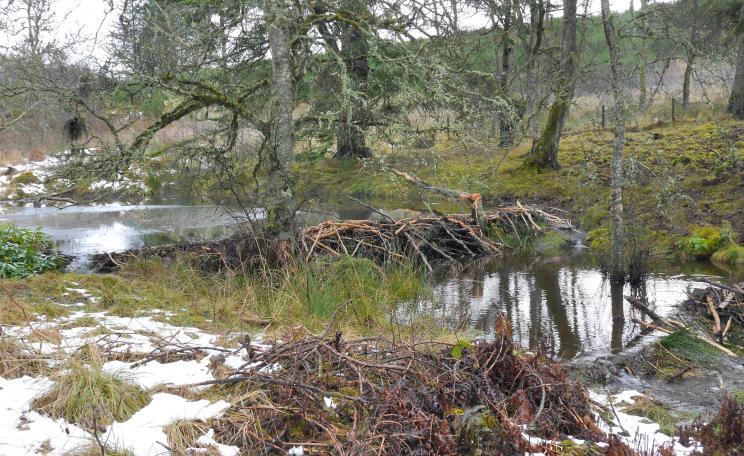Increasing red squirrel numbers benefits native forests, because they collect and bury thousands of tree seeds each autumn, which are often forgotten by the squirrels. Some of the seeds take root, spreading tree cover into nearby moorland and grassland.
An innovative project to boost the number of the UK's red squirrels by relocating individuals to woodlands they cannot reach by themselves is taking a major step forward this month.
Conservation experts at the charity Trees for Life will carefully relocate red squirrels from Inverness-shire and Moray to forests near Kinlochewe and at Plockton, where the species is currently absent despite there being suitable habitat for squirrels.
The Red Squirrel Reintroduction Project aims to establish 10 new populations in the northwest Highlands, significantly increasing both the numbers and range of the red squirrel in the UK.
"We are giving red squirrels a helping hand to return to some of their long-lost forest homes", said Becky Priestley, Trees for Life's Wildlife Officer.
"Many Highland woodlands offer the species excellent habitat far from disease-carrying grey squirrels - but because reds travel between trees and avoid crossing large areas of open ground, they can't return to isolated woodlands without our help."
Increasing red squirrel numbers benefits native forests, because red squirrels collect and bury thousands of tree seeds each autumn, which are often forgotten by the squirrels. Some of the seeds take root and grow into full size trees, revitalising existing woodland and spreading tree cover into nearby moorland and grassland.
The next two releases follow a successful first reintroduction in March this year, when the charity relocated 33 red squirrels from Forres and Strathspey to native woods at Shieldaig in Wester Ross. This new population has also bred during the summer, with several young squirrels observed - confirming that the area is excellent habitat with a good natural food supply.
There have also been regular sightings reported by local people, with the squirrels ranging widely as they explore nearby habitat. Trees for Life is continuing to monitor the population, with surveys planned for later this year.
Community support key to reintroduction success
Another success has been high levels of community involvement. Residents near the relocation sites have been monitoring the squirrels and carrying out supplementary feeding, while people from whose gardens the squirrels were removed have visited Shieldaig to see the expanding new population.
"Involving local communities is a big part of this exciting rewilding project. People love helping red squirrels and having them move into their local area", said Becky Priestley.
In the next phase of the project, this autumn 70 red squirrels will be relocated to sites have good habitat with significant potential for the species to spread into surrounding areas. These include the privately-owned Coulin Estate next to Beinn Eighe National Nature Reserve near Kinlochewe, and to Plockton, which is owned by several landowners including conservation charity The National Trust for Scotland.
Increasing red squirrel numbers benefits native forests, because they collect and bury thousands of tree seeds each autumn, which are often forgotten by the squirrels. Some of the seeds take root, spreading tree cover into nearby moorland and grassland.
The National Trust for Scotland is involved in protecting red squirrels across Scotland, and earlier this year reported its first sightings of the species in decades on the Trust's land in Fife and Perthshire.
There will be opportunities for people to help with monitoring the new squirrel populations, by reporting sightings and by taking part in surveys during the winter.
With animal welfare paramount, the project involves squirrels being transported in special nest boxes, lined with hay for comfort, and provisioned for food and hydration. Only small numbers of squirrels are removed from any site, so that donor populations are unaffected. Health checks ensure that diseased animals are not introduced to new populations.
At the reintroduction sites, the boxes are fixed to trees, with exit holes lightly filled with grass - allowing the squirrels to find their way out. Food is provided for several months while the squirrels become accustomed to their new habitat.
Scotland: the UK's last great stronghold for the reds
The red squirrel (Sciurus vulgaris) is a UK Biodiversity Action Plan priority species and lives in conifer-dominated boreal and broadleaved deciduous forests. Across much of Britain, it has been largely outcompeted by the introduced grey squirrel (Sciurus carolinensis).
In the UK, red squirrels are now rare with only an estimated 138,000 individuals left - their numbers decimated by the reduction of forests to isolated remnants, and by disease and competition from the introduced non-native grey squirrel. Greys are immune to and spread squirrel pox virus, which is lethal to reds.
Red squirrels occur throughout most of mainland Scotland, with the largest populations in the Highlands, and in Dumfries and Galloway. The Scottish population - estimated at 120,000 individuals - has increased slightly in recent years, but the animal's range and population would have been far larger before the loss of most of the Caledonian Forest. There are approximately 3,000 red squirrels in Wales and 15,000 in England.
All relocation sites require comprehensive habitat assessments, landowner agreements, and a five-year licence from Scottish Natural Heritage.
Oliver Tickell is contributing editor at The Ecologist.
More information about Trees for Life's award-winning work to restore the Caledonian Forest in the Highlands.
The Red Squirrel Reintroduction Project is building on a proven approach pioneered by Roy Dennis MBE of the Highland Foundation for Wildlife. It has been made possible by grants from the Heritage Lottery Fund and People's Trust for Endangered Species. It involves volunteer opportunities, landowner partnerships, and research to strengthen conservation. Website.







